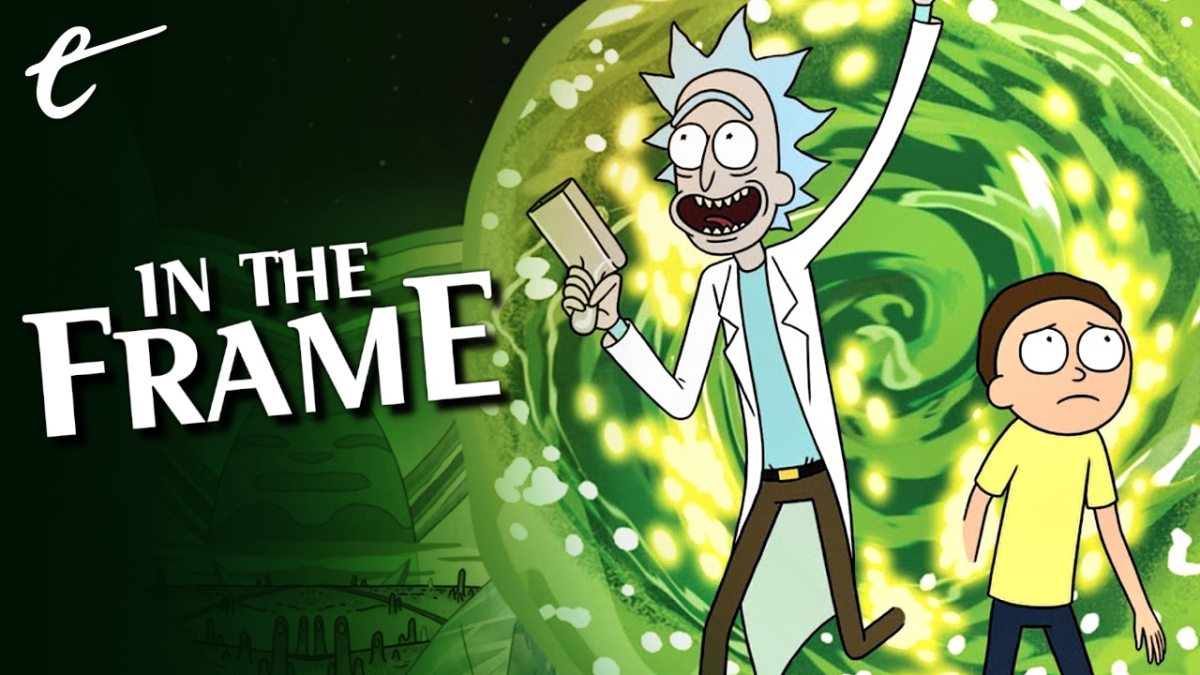The latest episode of Rick and Morty, “Mortiplicity,” is already being hailed as an instant classic.
The second episode of the fifth season premiered to strong reviews. At TechRadar, Samuel Roberts argued that it “might be the show’s greatest episode in years.” At IndieWire, Steve Greene stated that it was “the best the show has been in a while.” With an “A” grade at The A.V. Club, Zack Handlen praised “the strength of its ingenuity and its commitment to its premise.” At Variety, LaToya Ferguson contended that the episode was “a promising sign for this new season.”
However, “Mortiplicity” doesn’t represent a departure for Rick and Morty. Instead, it demonstrates something that the show has always done well. It plays to the strengths of Rick and Morty as a science fiction comedy. Co-creator and star Justin Roiland singled out the episode in pre-publicity for the season, boasting it was “fucking insane in the best way. It’s really a classic, over-the-top, Rick and Morty brain-melting episode. In a good way.”
Escalation is the key to both good comedy and good science fiction. Comedian Keegan-Michael Key argues that “premise plus escalation equals comedy.” Part of this is just the structural importance of repetition in comedy, the use of the “Rule of Three” to build an expectation and then subvert it. However, the key to building a great joke on top of a solid foundation is escalation. Studies suggest that, in the best jokes, each repetition involved “a progressive incremental shift in meaning.”
Similarly, a lot of great science fiction is built around the concept of heightening an already existing premise. Anthropologist Matthew Wolf-Meyer argues that science fiction operates in three modes, extrapolation, intensification, and mutation, which are all intended to serve as an escalation of the modern world. The famous reductive description of Black Mirror was “what if phones, but too much,” and that’s not entirely unfair. Science fiction starts with the familiar and escalates it.

Rick and Morty is rarely content to simply escalate the premise of a given episode. Instead, it exponentializes them within the tight confines of a standalone 20-minute episode of television. Rick and Morty will often start with a fairly straightforward science fiction premise and then accelerate its application to an absurdist degree. It doesn’t just repeat the joke and escalate the premise; it doubles down and then doubles down on the doubling down.
“Mortiplicity” is a great example of this. The episode opens with the primary cast sitting down for breakfast, getting ready for a routine adventure. However, breakfast is interrupted by an attack from hideous squid monsters that brutally murder the entire family. The episode then cuts to another version of the family, with Rick (Roiland) receiving a notification on his watch that one of his “decoy” families has been murdered. This is the starting premise of the episode.
However, “Mortiplicity” then spends its runtime building on that joke. It is quickly revealed that the second version of Rick is also a duplicate, which would be enough of a twist. However, it is subsequently revealed that many of Rick’s duplicates have also been creating their own duplicates and that the hideous squid monsters are actually just other copies of Rick and his family in disguise trying to murder their duplicates.
“Mortiplicity” constantly pulls backwards or sideways through the devices of another Rick receiving a notification that a set of duplicates have been murdered or through another Rick murdering the Rick who happens to be in focus at the time. That version of Rick is inevitably revealed to be a duplicate and then killed off so that the narrative can shift again. The gag is predicated on repetition extrapolated to recursion. It isn’t just the concept of clones; it’s the concept of clones cloning clones. Repetitio ad absurdum.

Illustrating the extent to which Rick and Morty fuses basic comedic structure with science fiction storytelling, the episode’s climax is a twist on the classic “brick joke” template, in which an element is introduced, brushed aside, and then returns to catch the audience off-guard. “Mortiplicity” opens with the second family having an unrelated adventure involving a strange figure named Mr. Always-Wants-to-Be-Hunted. He is quickly forgotten as the plot kicks in but returns at the climax to murder what appears to be the last surviving Rick for failing to hunt him.
Rick and Morty embraced this exponential approach to plotting as early as its second episode, “Lawnmower Dog.” That episode’s primary plot is a riff on Inception, with Rick and Morty (also Roiland) infiltrating the dreams of Morty’s math teacher, Mr. Goldenfold (Brandon Johnson) before infiltrating the dreams of characters within Goldenfold’s dream. It is dreams all the way down. The plot itself is an escalation of the already recursive structure of Christopher Nolan’s Inception.
This structural approach to a science fiction high concept is also reflected in the secondary story thread that gives the episode its title. To appease his family, Rick makes the family dog Snuffles (Rob Paulsen) smart enough to use the bathroom. However, Snuffles then uses that intelligence to make himself even smarter in a riff on the idea of the technological singularity — the idea that mankind might one day create machines that are smart enough to exponentially improve themselves.
This tendency towards recursion and escalation is key to many classic Rick and Morty episodes. “Meeseeks and Destroy” features a device that summons a helpful artificial lifeform named Mr. Meeseeks (also Roiland) to help its summoner complete a task. Inevitably, when Mr. Meeseeks is confronted with a task that it cannot solve, it creates its own Mr. Meeseeks to solve the problem. Naturally, the situation escalates at an exponential rate.

“Total Rickall” is built around alien memory parasites that multiply every time the characters try to remember something. “One Crew Over the Crewcoo’s Morty” is an escalation of classic heist movie tropes, in which every stage of a con is revealed itself to be a con. “Never Ricking Morty” imagines a train powered by narrative, hoping to run on enough meta energy to break the fifth wall. “The Vat of Acid Episode” finds Morty creating an infinite array of alternate universes.
This use of exponential escalation in Rick and Morty assumes that modern audiences are acutely media-literate. This plotting is built upon the assumption that the viewer is at least casually familiar with the basic premises from which these stories are starting. “Mortiplicity” is obviously riffing on the basic idea of the 1996 film Multiplicity, but the episode explicitly cites Westworld and Ex Machina (and Highlander!) as frames of reference for its central plot.
This makes sense. Modern audiences tend to be more media-literate. They are more familiar with how narratives work, simply because they have easier access to more media than any prior generation. “How many hours of serial killer plot has the average viewer seen?” asked writer Paul Schrader in 2009. “Fifty? A hundred? He’s seen the basic plots, the permutations of those plotlines, the imitations of the permutations of those plotlines and the permutations of the imitations.”
Less adventurous and ambitious media than Rick and Morty understand this. This understanding underpins the winking and self-aware humor of a lot of modern blockbusters, aiming to hide that exhausting familiarity behind knowing jokes that reassure audiences that they’re in on the joke. In many cases, these sorts of jokes are designed to excuse the recycling of tired clichés and setups — the film or television show defensively making the joke so the audience at home can’t do it first.

However, some media understands how audience familiarity with these conventions can be used to enhance the story being told. Spider-Man: Into the Spider-Verse assumes audiences are so familiar with Spider-Man’s origin that it can speedrun six variations of it within a two-hour runtime and that audiences understand the logic of a tragic supervillain origin clearly enough that it can offer Wilson Fisk (Liev Schreiber) a heartbreaking backstory in 90 seconds without labored exposition.
Critic Elizabeth Sandifer coined the term “narrative acceleration” to describe the work of writer Steven Moffat on Sherlock and Doctor Who, who would often use the audience’s literacy and fluency in basic narrative mechanics to speed up and intensify the storytelling in his work. “The Great Game,” the first season finale of Sherlock, burns through five Sherlock Holmes stories in 90 minutes — at an average of 18 minutes per story — creating a narrative rollercoaster.
Co-creator Dan Harmon concedes there is “a heavy dose of Doctor Who” in Rick and Morty. However, Rick and Morty takes this accelerationist approach and escalates it even further. Film critic David Bordwell argued that, with its five levels of recursion, Christopher Nolan’s Inception respected “the limits of recursive thinking.” It feels pointed that Rick and Morty‘s second episode took a concept that audiences had already embraced at its limits and then pushed it even further.
There is a solid argument to be made that Rick and Morty is a bleakly nihilistic piece of work, with its characters often unsure of their own reality, and its multiverse suggesting that individual choice may be meaningless. However, Rick and Morty simply reflects a world that is increasingly overwhelming and insane. Its constant heightening and acceleration of familiar tropes offers a mirror of a world where reality appears to be unraveling and everything happens so fast.
Of course, it’s an old cliché that nothing kills a joke faster than explaining it. So maybe it’s enough to acknowledge that Rick and Morty is also just consistently funny.





